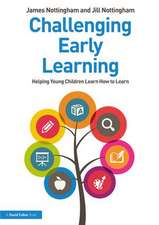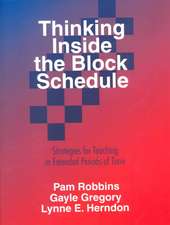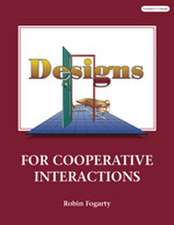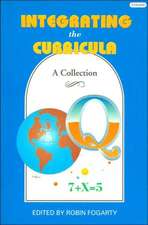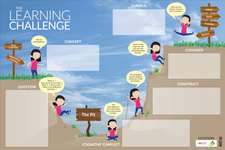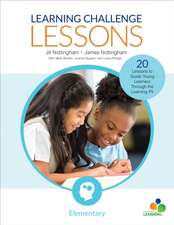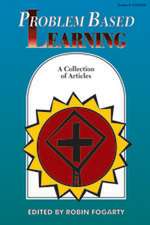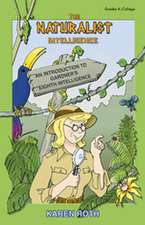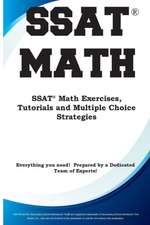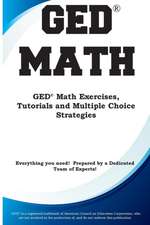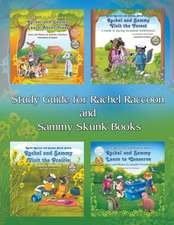Challenging Learning Through Feedback: How to Get the Type, Tone and Quality of Feedback Right Every Time: Corwin Teaching Essentials
Autor James A. Nottingham, Jill Nottinghamen Limba Engleză Paperback – 14 mar 2017
Feedback has the potential to dramatically improve student learning – if done correctly. In fact, providing high quality feedback is one of the most critical roles of a teacher. But if feedback is not done correctly it can have a minimal – or even negative effect – on learning. Challenging Learning Through Feedback provides educators with the tools they need to establish clear learning intentions and success criteria in order to craft high quality feedback and avoid common feedback mistakes. Readers will learn
- When feedback is (and isn’t) working
- How to design feedback so that it answers three essential questions
- Strategies for crafting clear Learning Intentions and Success Criteria
- How to teach students to give high quality feedback to themselves and others
"Feedback – a noun or a verb? A separate practice or an integral part of the learning process? Something we do ‘to students’ or ‘with students’? The Nottinghams sort it all out for us – the ‘what,’ ‘why,’ and ‘how’ of the process and the practice of feedback.”
Barb Pitchford, Co-author
Leading Impact Teams: Building a Culture of Efficacy (2016)
"Finally a practical book on feedback for teachers! It is written with the teacher in mind, lesson plan in hand, and relevant to all in education. The perfect school-wide study book!"
Lisa Cebelak, Education Consultant
Grand Rapids, MI
Din seria Corwin Teaching Essentials
-
 Preț: 197.23 lei
Preț: 197.23 lei -
 Preț: 282.10 lei
Preț: 282.10 lei -
 Preț: 247.31 lei
Preț: 247.31 lei -
 Preț: 278.92 lei
Preț: 278.92 lei -
 Preț: 245.89 lei
Preț: 245.89 lei -
 Preț: 189.99 lei
Preț: 189.99 lei -
 Preț: 281.38 lei
Preț: 281.38 lei -
 Preț: 216.12 lei
Preț: 216.12 lei -
 Preț: 195.85 lei
Preț: 195.85 lei -
 Preț: 165.86 lei
Preț: 165.86 lei -
 Preț: 280.37 lei
Preț: 280.37 lei -
 Preț: 269.07 lei
Preț: 269.07 lei -
 Preț: 290.65 lei
Preț: 290.65 lei -
 Preț: 154.25 lei
Preț: 154.25 lei -
 Preț: 275.92 lei
Preț: 275.92 lei -
 Preț: 278.92 lei
Preț: 278.92 lei -
 Preț: 191.99 lei
Preț: 191.99 lei -
 Preț: 228.05 lei
Preț: 228.05 lei -
 Preț: 274.24 lei
Preț: 274.24 lei -
 Preț: 152.25 lei
Preț: 152.25 lei -
 Preț: 188.51 lei
Preț: 188.51 lei -
 Preț: 278.10 lei
Preț: 278.10 lei -
 Preț: 288.05 lei
Preț: 288.05 lei -
 Preț: 239.30 lei
Preț: 239.30 lei -
 Preț: 191.99 lei
Preț: 191.99 lei -
 Preț: 272.03 lei
Preț: 272.03 lei -
 Preț: 185.60 lei
Preț: 185.60 lei -
 Preț: 175.41 lei
Preț: 175.41 lei -
 Preț: 192.18 lei
Preț: 192.18 lei -
 Preț: 270.70 lei
Preț: 270.70 lei -
 Preț: 271.26 lei
Preț: 271.26 lei -
 Preț: 276.90 lei
Preț: 276.90 lei -
![Answers to Your Biggest Questions About Creating a Dynamic Classroom: Five to Thrive [series]](https://i3.books-express.ro/bs/9781071856789/answers-to-your-biggest-questions-about-creating-a-dynamic-classroom.jpg) Preț: 235.32 lei
Preț: 235.32 lei -
 Preț: 269.35 lei
Preț: 269.35 lei -
 Preț: 85.05 lei
Preț: 85.05 lei -
 Preț: 191.94 lei
Preț: 191.94 lei -
 Preț: 269.35 lei
Preț: 269.35 lei -
 Preț: 191.99 lei
Preț: 191.99 lei -
 Preț: 185.60 lei
Preț: 185.60 lei -
 Preț: 268.25 lei
Preț: 268.25 lei -
 Preț: 246.82 lei
Preț: 246.82 lei -
 Preț: 284.12 lei
Preț: 284.12 lei -
 Preț: 196.17 lei
Preț: 196.17 lei -
 Preț: 245.70 lei
Preț: 245.70 lei -
 Preț: 246.00 lei
Preț: 246.00 lei -
 Preț: 276.19 lei
Preț: 276.19 lei -
 Preț: 278.61 lei
Preț: 278.61 lei -
 Preț: 277.83 lei
Preț: 277.83 lei -
 Preț: 277.01 lei
Preț: 277.01 lei
Preț: 196.64 lei
Nou
37.63€ • 39.39$ • 31.32£
Carte disponibilă
Livrare economică 10-24 martie
Livrare express 21-27 februarie pentru 29.43 lei
Specificații
ISBN-10: 1506376908
Pagini: 184
Dimensiuni: 216 x 279 x 15 mm
Greutate: 0.47 kg
Ediția:Adaptată
Editura: SAGE Publications
Colecția Corwin
Seria Corwin Teaching Essentials
Locul publicării:Thousand Oaks, United States
Recenzii
"This was a thought provoking read and one I will reference over and over again. The authors have created a thorough reference for all teachers working to make their feedback impact learning, not only student learning, but their own. This will be a valuable reference for educators for years to come. I think that this reaches beyond classroom walls and will also help administrators model feedback for teachers and make an impact on the growth of student achievement."
"This book is a must-have for teachers. It’s easy-to-read and easy-to-implement. Feedback provided at the right time and in the right manner increases student motivation and learning outcome. It is relevant for all grade levels."
"A great tool for professional development and personal growth for any educator. This book is the add-on I need during feedback sessions. Teachers need the examples and explanations this book offers."
"With the rapid emergence of formative assessment used in support of learning, refinements also are emerging in our understanding of how to use of descriptive feedback during learning to promote student success. This new book provides the most up-to-date and complete treatment synthesis of those understandings. Rare is the book that offers guidance both to scholars and practitioners, but this book does both."
"This book is for anyone who wants to help others get better. I found myself taking notes in chapter after chapter because of the practical advice based on succinct summaries of research and evidence. I could incorporate the ideas in my classes the next day. Nottingham and Nottingham remind us that “to assess” means “to sit beside.” They come alongside us as readers to help us better understand how to move beyond advice and evaluation to feedback that leads to improvement."
"Feedback – a noun or a verb? A separate practice or an integral part of the learning process? Something we do ‘to students’ or ‘with students’? The Nottinghams sort it all out for us – the ‘what,’ ‘why,’ and ‘how’ of the process and the practice of feedback. A simply and elegantly organized book with tons of resources that guide educators to practice quality feedback. A ‘must read’ for all teacher teams!"
"This book is an accessible and comprehensive guide - one that provides the whole picture when it comes to offering quality feedback to deepen student learning. Each chapter ends with questions that inspired me to reflect and take a hard look at where I am in my feedback journey. Busy instructional leaders will appreciate the organizational structure of the book as well as the clear definitions and practical examples that can used to help teachers envision the ideas into practice."
"Finally a practical book on feedback for teachers! The Nottinghams cut through the hype and misinformation and brings teachers a valuable tool they will want to revisit often throughout their career. It is written with the teacher in mind, lesson plan in hand, and relevant to all in education. The perfect school-wide book study book!"
"James and Jill Nottingham have once again equipped educators with practical applications and examples of how to not only increase learning, but ensure it will happen at the greatest possible levels. They provide teachers with strategies for creating the culture their classrooms need to help students reach the “Eureka moments” where learning becomes accelerated by the students…and their desire to grow and learn even more is augmented. Finally, they deliver rich guiding examples for teachers to increase teacher clarity through the development of high quality learning intentions and success criteria to help students know when they have met these intentions. This is an essential foundational element for feedback to have a place to originate from and be effective for learning. I highly recommend this book as a bucket-list read for any educator!"
"Not only does this book support teachers in developing a deep understanding of quality descriptive feedback, the authors give practical examples of how to design learning intentions and success criteria to lift the quality of feedback during lessons. The authors offer innovative feedback tools based on The Learning Challenge (The Learning Pit); these innovative tools will support teachers in ensuring that feedback is reliable and valid when partnering with students to create a true learning culture!"
"James Nottingham’s work on Challenging Learning is a critical element of creating Visible Learners. This new series will help teachers hone the necessary pedagogical skills of dialogue, feedback, questioning, and mindset. There’s no better resource to encourage all learners to know and maximize their impact!"
Cuprins
The Challenging Learning Story
Foreword by Shirley Clarke
Acknowledgements
About the Authors
Contributors
Introduction
The Language of Learning
Chapter 1: Setting the Scene
1.0 Why Read Yet Another Book About Feedback?
1.1 What Is Feedback?
1.2 Assessment: To Sit Beside
1.3 Four Levels of Feedback
1.4 Matching Feedback to Levels of Understanding (Using the SOLO Taxonomy)
1.5 Praise vs. Feedback
1.6 Does Grading Count as Feedback?
1.7 Other Types of Feedback
1.8 Review
1.9 Next Steps
Chapter 2: Current Reality
2.0 What Is Your Feedback Like Now?
2.1 Characteristics of Excellent Feedback
2.2 Corrective, Component and Comprehensive Feedback
2.3 Extending Feedback
2.4 Review
2.5 Next Steps
Chapter 3: Creating a Culture for Feedback
3.0 Feedback Utopia
3.1 Ten Ways to Build Towards Feedback Utopia
3.2 Review
3.3 Next Steps
Chapter 4: Goals Before Feedback
4.0 Feedback Should Refer to Learning Goals
4.1 Long-Term and Short-Term Goals
4.2 Learning Intentions (LI) and Success Criteria (SC)
4.3 How to Design Effective LI and SC
4.4 Example LI and SC to Use With Five- to Eleven-Year-Olds
4.5 Example LI and SC to Use With Eleven- to Eighteen-Year-Olds
4.6 Learning Goals for Working Together
4.7 Review
4.8 Next Steps
Chapter 5: Taxonomies to Support Goal Setting
5.0 Learning How to Learn
5.1 Using Taxonomies Wisely
5.2 Bloom’s Taxonomy (and Beyond)
5.3 The EDUCERE Taxonomy of Thinking Skills
5.4 The ASK Model
5.5 Footnote to Taxonomies: Beware!
5.6 Review
5.7 Next Steps
Chapter 6: Feedback and the SOLO Taxonomy
6.0 The SOLO Taxonomy
6.1 How the SOLO Taxonomy Relates to the Learning Challenge
6.2 How the SOLO Taxonomy Relates to Feedback
6.3 How the SOLO Taxonomy Relates to Learning
6.4 The SOLO Treehouse
6.5 Review
6.6 Next Steps
Chapter 7: Seven Steps to Feedback
7.0 Background
7.1 Using the Seven Steps to Feedback
7.2 The Seven Steps to Feedback: Some Final Thoughts
7.3 But There’s No Time!
7.4 Review
7.5 Next Steps
Chapter 8: Tools for Feedback
8.0 Using the Learning Challenge to Generate Feedback Questions
8.1 Learning Challenge Feedback Questions: Stage 1
8.2 Learning Challenge Feedback Questions: Stage 2
8.3 Learning Challenge Feedback Questions: Stage 3
8.4 Learning Challenge Feedback Questions: Stage 4
8.5 Learning Detectives
8.6 Examples of Clues for Learning Detectives to Search For
8.7 Review
8.8 Next Steps and Further Reading
Repertoire and Judgement Notes
References
Index
Notă biografică
James Nottingham is co-founder and director of Challenging Learning, a group of companies with 30 employees in 6 countries. His passion is in transforming the most up-to-date research into strategies that really work in the classroom. He is regarded by many as one of the most engaging, thought-provoking and inspirational speakers in education.
His first book, Challenging Learning, was published in 2010 and has received widespread critical acclaim. Since then, he has written 6 books for teachers, leaders, support staff, and parents. These books share the best research and practice connected with learning; dialogue; feedback; the learning pit; early years education; and growth mindset.
Before training to be a teacher, James worked on a pig farm, in the chemical industry, for the American Red Cross, and as a teaching assistant in a school for deaf children. At university, he gained a first-class honours degree in education (a major turnaround after having failed miserably at school). He then worked as a teacher and leader in primary and secondary schools in the UK before co-founding an award-winning, multi-million-pound regeneration project supporting education, public and voluntary organisations across north east England.
Skolvärlden (Swedish Teaching Union) describes James as ¿one of the most talked about names in the world of school development¿ and the Observer newspaper in the UK listed him among the Future 500 - a ¿definitive list of the UK¿s most forward-thinking and brightest innovators.¿

